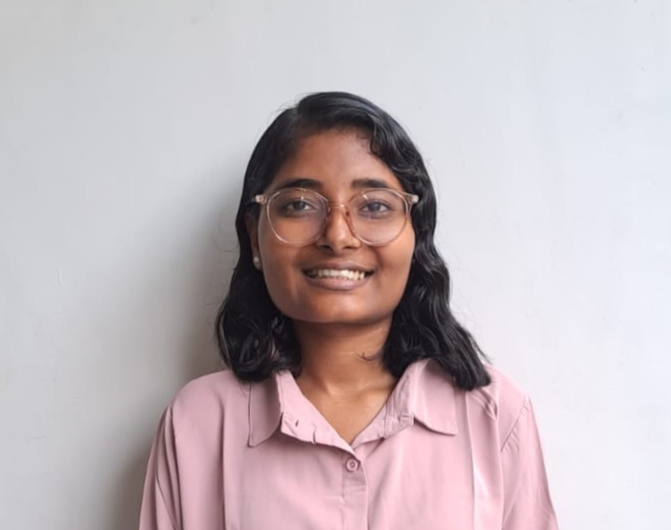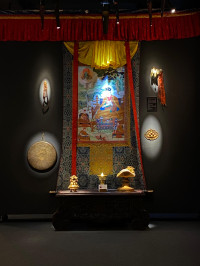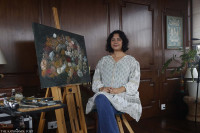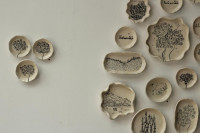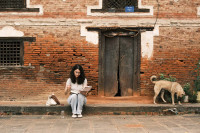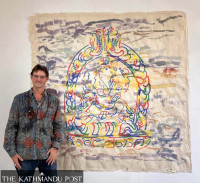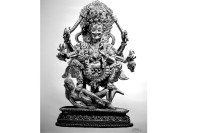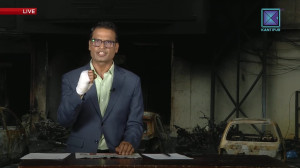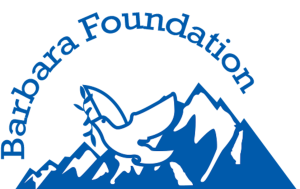Arts
Lives of rural trans women in Madhesh
Blue Diamond Society’s photovoice exhibit ‘Sweekar’ presents the raw, unfiltered experiences of rural trans women, highlighting their struggles and resilience.
Aarati Ray
Siddhartha Art Gallery felt quite different last Saturday. With the sweltering heat in Kathmandu, you might think it was the glare of the sun, but it was more about the joyful energy of the ‘Nepal Pride Parade’. The gallery, which is usually adorned with huge canvas frames and majestic pieces of art, with paintings from traditional to abstract, had way smaller photo frames lined up. The photo frames looked too simple, with ordinary pictures.
One might have speculated whether the photos were captured by skilled professionals or if they were groundbreaking shots taken by daring photographers or investigative journalists, given that they were intended for an exhibition. However, from a single look, it could be seen that the photos were taken by no experts, just ordinary people.
Yet, when one looked at them, they couldn’t take their eyes off them, for these photos captured the everyday lives of rural trans women—a group often forgotten and overlooked because of the dominant mainstream focus on the urban, upper-class LGBTQIA+ community.
Blue Diamond Society (BDS), a pioneering organisation advocating for sexual and gender minorities in Nepal, organised a two-day photovoice exhibit titled ‘Sweekar’ from June 8 to June 9 at the Siddhartha Art Gallery, Babermahal Revisited, Kathmandu. This exhibit, coinciding with Pride Month and the Nepal Pride Parade, showcased the stories of rural transgender women from Madhesh Province, Nepal.
Through 15-20 compelling photographs, selected and narrated by the women themselves, the exhibit provided a glimpse into their lived experiences and the intersectional stigma they face regarding gender identity and HIV healthcare.
According to the organisers, ‘Sweekar’, meaning acceptance, is a multi-prong effort to examine and address the intersectional stigma experienced by trans women living in Madhesh Province.
Photovoice, a method designed to spark verbal discussions on significant community issues, has been widely utilised in health education. Fifteen trans women were invited to participate in two three-day photovoice workshops in Janakpur.
They worked with a trained facilitator to learn how to use photography to share their lived experiences of stigma. In the second workshop, the facilitator reviewed hundreds of photos with the participants and distilled them down to the photos exhibited, which represented the issues most important to trans women.
Manisha Dhakal, executive director of Blue Diamond Society, stated, “This is not a typical photo exhibition to be viewed from an artistic perspective. We are not romanticising the pain and struggles of the trans community. These are their unheard stories and hidden pain. Through this exhibit, we aim to provide a platform for trans women to share their challenges and progress”.
True to Dhakal’s sentiment, the photos revealed the lives and struggles of rural trans women in Madhesh. Each photo was accompanied by short quotes from the women, adding depth and meaning.
For the first time in my experience at an art gallery, there was no artist's perspective, only the raw, unfiltered voices of the people depicted. One photo showed a trans woman carrying a bag on her head, with a quote, “Heading to India for a performance. Walking because public vehicles wouldn’t let me board.” Another showed a trans woman carrying a milk pot with the quote, “People hesitate to buy milk from me because I'm queer. It’s hard to survive.”
Likewise, another photo showed a trans woman in a sari with torn clothes, accompanied by the quote, “When we go to the market, people tear our clothes, they don’t respect us, sometimes they rape.”
The phrase “sometimes they rape” was used so casually, yet it starkly depicts the harsh reality faced by trans women, who have become so vulnerable and accustomed to violence like harassment and rape that they speak of it lightly.
For me, “sometimes” had always been associated with trivial activities like “sometimes I sing”, “sometimes I go climbing”, or “sometimes I write”, but hearing “sometimes they rape” was shocking and took on a new heavy meaning.

Through the photos, the audience could see the vulnerable realities of trans women in rural areas. Even research indicates that rural transgender and gender-diverse (TGD) populations have a greater need for health services compared to their urban counterparts. They face unique barriers to accessing these services, and their health disparities are less researched than those of urban TGD populations.
Another study shows that trans women in Nepal are highly stigmatised, leading to factors that increase their risk for HIV. Interventions are needed to support the economic and mental well-being of trans women to mitigate the heightened HIV risk from stigma. However, the healthcare systems and acceptance are lacking.
Pinky Gurung, president of BDS, opined, “Through this, we aim to educate the general public, policymakers, and stakeholders about the realities faced by trans women in Nepal and advocate against the anti-gender movement.”
The exhibit also featured a video collage of the daily lives of trans women. It showed how trans women are like any other people who wish to have ordinary lives but are forced to endure difficult lives due to societal stigma. It also showcased rare instances where trans women received necessary help and healthcare, offering hope for a more positive and accepting society.
The exhibit's standout feature was that the photos were taken by trans women themselves, adding authenticity and a personal connection to their daily lives.
The ‘Sweekar’ photovoice exhibit celebrates the achievements of the LGBTQIA+ community and underscores the need for continued action towards inclusivity and better health outcomes for all, especially trans women.
Dr Erin Wilson, principal investigator of Sweekar, said, “Through photovoice, a participatory research method promoting critical self-awareness within social contexts, we hope to empower individuals to challenge stereotypes and reduce stigma towards trans women and HIV in Nepal while boosting empowerment and social support.”
The exhibit moved to Janakpur on Monday and was presented yesterday at Mithila Yatri Niwas, Janakpur, from 12 pm onwards. Those who missed it in Kathmandu can visit the Sweekar website to view the photos and narrations.




 16.07°C Kathmandu
16.07°C Kathmandu